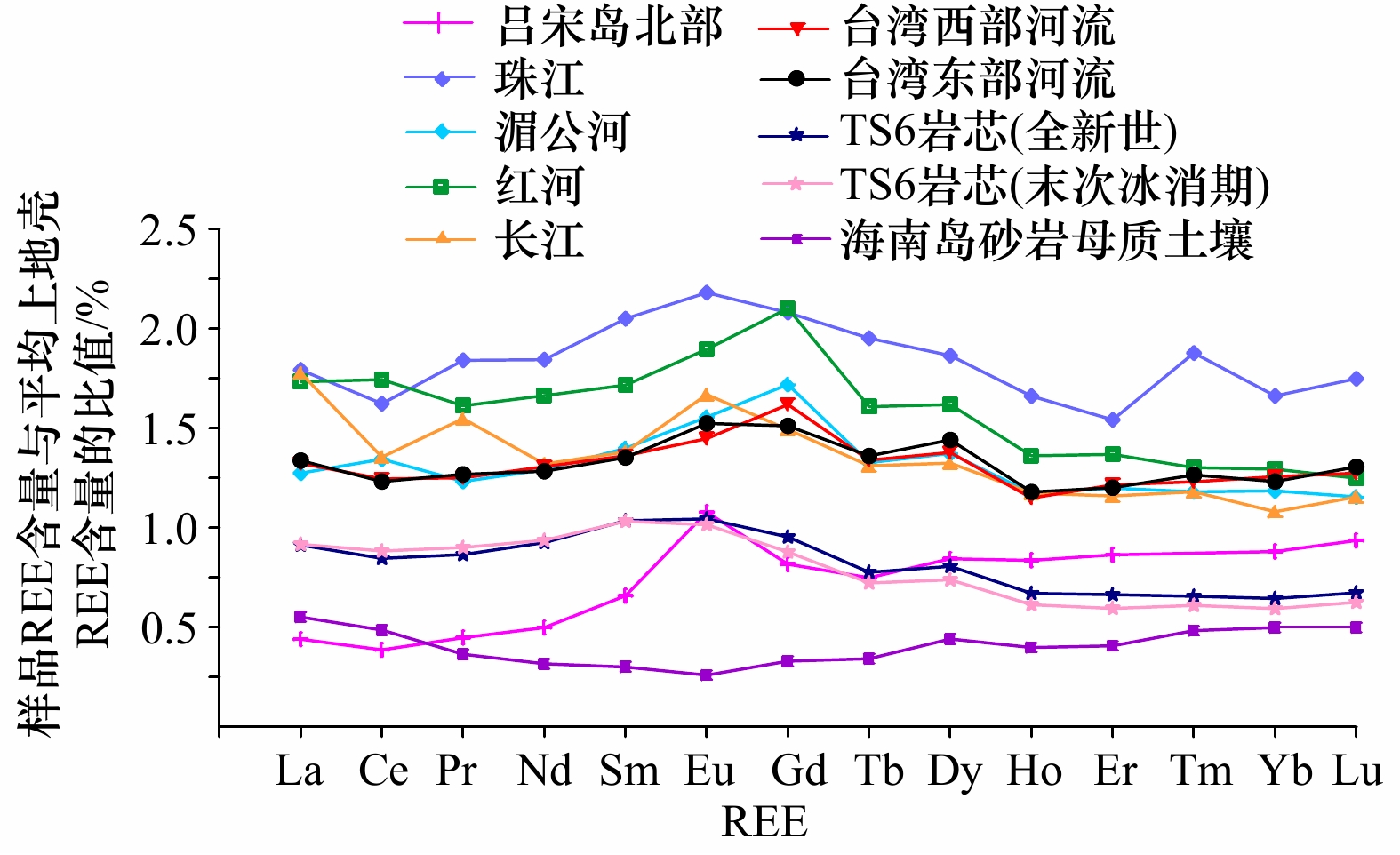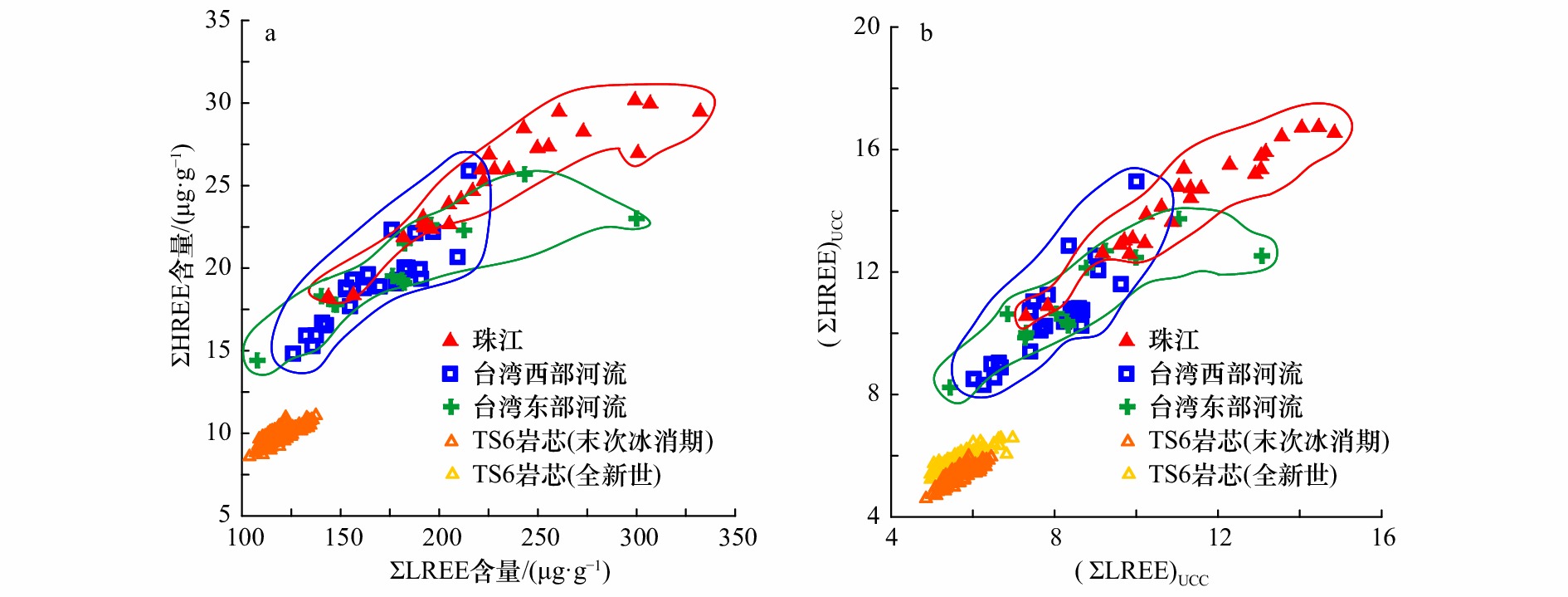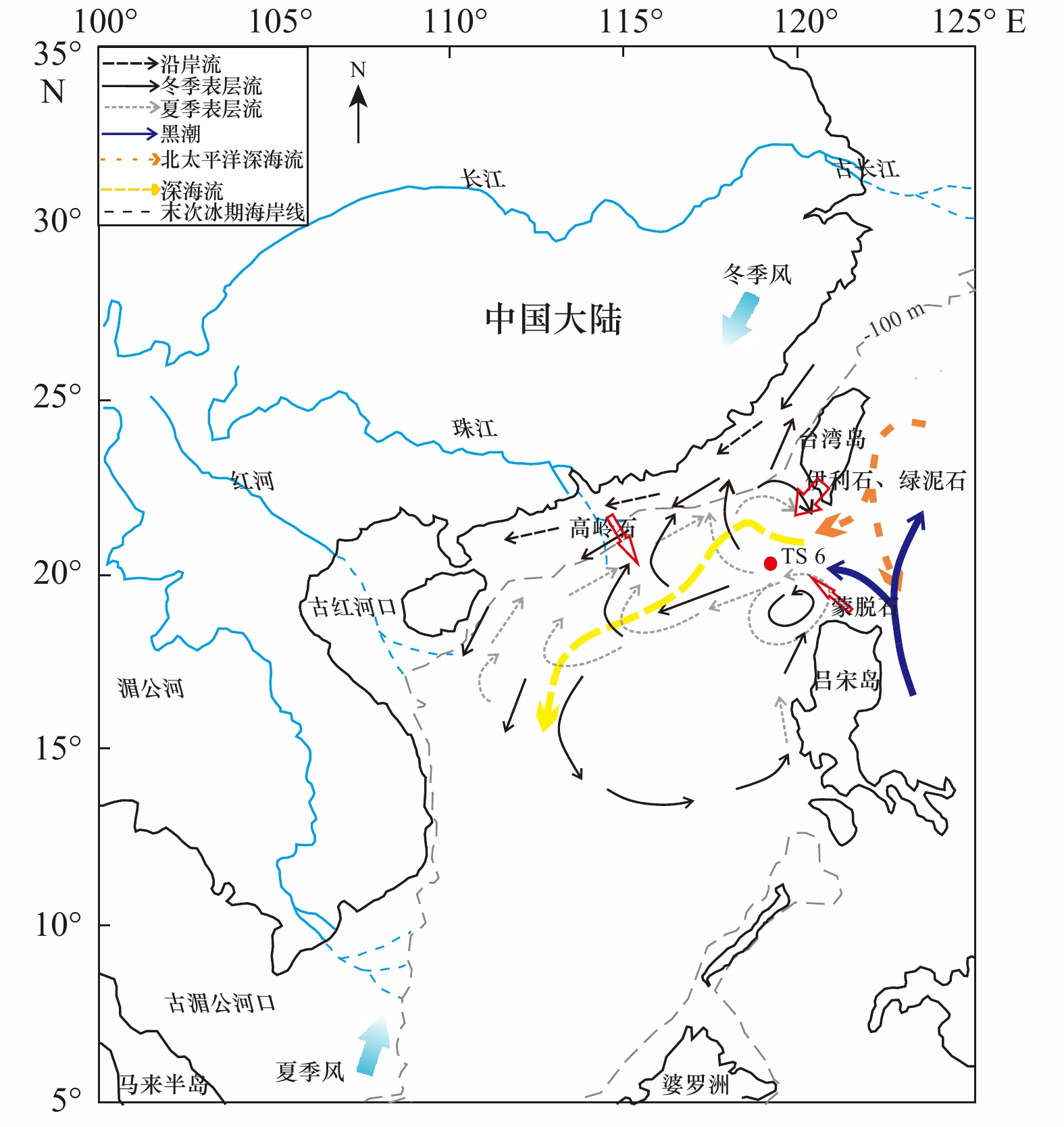Analysis on the provenance and transport mechanism of sediments in the southern area of Southwest Taiwan Basin, South China Sea over the last 19 ka
-
摘要: 通过对南海台西南盆地南部海域TS6岩芯沉积物样品稀土元素地球化学特征和黏土矿物组合进行分析,探讨了研究区近19 ka (末次冰消期)以来沉积物物质来源、输运机制及物源变化特征。物源综合分析结果显示,台湾河流是研究区沉积物的主要源区,其中台湾西部河流较东部河流贡献更大,珠江也为研究区输送了部分沉积物。由于各源区物质主要黏土矿物种类及含量存在较大差异,推测研究区沉积物黏土矿物中的伊利石和绿泥石主要由台湾河流提供,高岭石主要由珠江提供,含量较少的蒙脱石由东南部的吕宋岛提供。末次冰消期以来,研究区陆源物质输入量受控于海平面变化而逐渐减少,黏土矿物组合反映的物源变化主要受控于气候和洋流变化,还可能叠加了多种因素的影响。Abstract: Based on the analysis of the rare earth element (REE) geochemical characteristics and clay mineral assemblages of Core TS6 sediment samples in the southern area of Southwest Taiwan Basin, South China Sea, the provenance and characteristics of its changes, material transport mechanism of sediments in the study area over the last 19 ka (the last deglaciation) are discussed. The comprehensive analysis of provenance shows that the rivers in Taiwan are the main provenance of sediments in the study area. The rivers in the west of Taiwan contribute more than the rivers in the east, and the Zhujiang River also transports part of sediments to the study area. Due to the large differences on the types and contents of the main clay minerals in different provenance areas, it is judged that the illite and chlorite of the clay minerals in the study area are mainly provided by the rivers in Taiwan; the kaolinite is mainly provided by the Zhujiang River and the less content of montmorillonite is provided by Luzon Island in the southeast. Since the last deglacial period, the input of terrigenous materials in the study area has been gradually reduced under the control of sea level changes. The provenance changes reflected by the combination of clay minerals are mainly controlled by changes in climate and ocean currents, and the influence of multiple factors may be superimposed.
-
图 4 TS6岩芯沉积物与潜在物源区REE上地壳标准化分布
台湾河流数据引自文献[29],吕宋岛北部数据引自文献[30],珠江数据引自文献[31],红河和湄公河数据引自文献[32],长江数据引自文献[33],海南岛数据引自文献[34]
Fig. 4 REE upper crust standardized distribution of Core TS6 sediments and potential provenance area
The data of rivers in Taiwan are cited from reference [29], the data of northern Luzon Island are cited from reference [30], the data of Zhujiang River are cited from reference [31], the data of Red River and Mekong River are cited from reference [32], the data of Changjiang River are cited from reference [33], the data of Hainan Island are cited from reference [34]
图 5 TS6岩芯沉积物与潜在物源区的REE分异参数对比
台湾河流数据引自文献 [29],吕宋岛北部数据引自文献 [30],珠江数据引自文献 [31],长江数据引自文献 [33]
Fig. 5 Comparison of REE differentiation parameters between Core TS6 sediments and potential provenance areas
The data of rivers in Taiwan are cited from reference [29], the data of northern Luzon Island are cited from reference [30], the data of Zhujiang River are cited from reference [31], the data of Changjiang River are cited from reference [33]
图 6 TS6岩芯沉积物与潜在物源区的轻重稀土及其上地壳标准化值分布对比
Fig. 6 Comparison of the light and heavy rare earth elements and their normalized value distribution of Core TS6 sediments and potential provenance areas
The data of rivers in Taiwan are cited from reference [29], the data of Zhujiang River are cited from reference [31]
图 7 TS6岩芯沉积物高岭石−(伊利石+绿泥石)−蒙脱石三角端元图
台湾河流数据引自文献[36],珠江数据引自文献[37],吕宋岛数据引自文献[38],湄公河和红河数据引自文献[39],长江数据引自文献[40],海南岛数据引自文献[12]
Fig. 7 Kaolinite-(illite+chlorite)-montmorillonite triangular end member diagram of Core TS6 sediments
The data of rivers in Taiwan are cited from reference [36], the data of Zhujiang River are cited from reference [37], the data of northern Luzon Island are cited from reference [38], the data of Red River and Mekong River are cited from reference [39], the data of Changjiang River are cited from reference [40], the data of Hainan Island are cited from reference [12]
图 8 TS6岩芯沉积物伊利石结晶度与伊利石风化指数判别图
台湾河流数据引自文献 [36],珠江数据引自文献 [37],长江数据引自文献 [40]
Fig. 8 Illite crystallinity-illite chemical index discriminant diagram of Core TS6 sediments
The data of rivers in Taiwan are cited from reference [36], the data of Zhujiang River are cited from reference [37], the data of Changjiang River are cited from reference [40]
表 1 TS6岩芯REE含量及相关参数
Tab. 1 REE content and related parameters of Core TS6
参数 ΣREE含量/10−6 ΣLREE含量/10−6 ΣHREE含量/10−6 LREE/HREE (La/Yb)UCC (La/Sm)UCC (Gd/Yb)UCC δCe值 δEu值 最大值 158.47 146.98 12.22 12.92 1.89 0.96 1.80 1.03 0.72 最小值 112.21 101.76 8.59 9.55 1.13 0.81 1.34 0.94 0.59 平均值 129.56 119.20 10.36 11.52 1.49 0.89 1.48 0.98 0.66 注:UCC为上地壳。 表 2 TS6岩芯黏土矿物含量及相关参数
Tab. 2 Clay mineral content and related parameters of Core TS6
黏土矿物 伊利石含量/% 绿泥石含量/% 高岭石含量/% 蒙脱石含量/% 伊利石结晶度/°Δ2θ 伊利石风化指数 最大值 68.71 24.04 11.27 7.19 0.31 0.47 最小值 62.37 18.75 7.76 0.15 0.26 0.29 平均值 64.94 20.78 9.38 4.90 0.29 0.36 -
[1] 梅西, 张训华, 李日辉, 等. 南黄海北部晚更新世以来常量元素记录的化学风化作用[J]. 沉积学报, 2014, 32(5): 846−854.Mei Xi, Zhang Xunhua, Li Rihui, et al. Chemical weathering recorded by major element of Northern South Yellow Sea since Late Pleistocene[J]. Acta Sedimentologica Sinica, 2014, 32(5): 846−854. [2] McLennan S M. Rare earth elements in sedimentary rocks: influence of provenance and sedimentary processes[M]//Lipin B R, Mckay G A. Reviews of Mineralogy. Washington DC: Mineralogical Society of America, 1989, 21: 169−200. [3] 赵德博, 万世明. 南海沉积物中黏土矿物及其在古气候中的应用研究进展[J]. 海洋地质与第四纪地质, 2014, 34(4): 163−171.Zhao Debo, Wan Shiming. Research progress of clay minerals in sediments of the South China Sea and its application to paleoclimatic reconstruction[J]. Marine Geology & Quaternary Geology, 2014, 34(4): 163−171. [4] Rateev M A, Gorbunova Z N, Lisitzyn A P, et al. The distribution of clay minerals in the oceans[J]. Sedimentology, 1969, 13(1/2): 21−43. [5] Gingele F X, De Deckker P, Hillenbrand C D. Clay mineral distribution in surface sediments between Indonesia and NW Australia-source and transport by ocean currents[J]. Marine Geology, 2001, 179(3/4): 135−146. [6] 周庆杰, 李西双, 刘乐军, 等. 基于Chirp数据和Biot-Stoll模型反演南海北部陆坡海底表层沉积物物理性质[J]. 海洋学报, 2020, 42(3): 72−82.Zhou Qingjie, Li Xishuang, Liu Lejun, et al. Physical properties of the seabed inversed based on Chirp data and the Biot-Stoll model in the northern continental slope of the South China Sea[J]. Haiyang Xuebao, 2020, 42(3): 72−82. [7] 刘丛舒, 丁巍伟, 殷绍如, 等. 南海北部陆坡区海底峡谷地貌、沉积特征及控制因素[J]. 海洋学研究, 2019, 37(2): 28−43.Liu Congshu, Ding Weiwei, Yin Shaoru, et al. Geomorphology, sedimentary characteristics and controlling factors of submarine canyons in the northern continental slope of the South China Sea[J]. Journal of Marine Sciences, 2019, 37(2): 28−43. [8] 周航, 刘乐军, 徐元芹, 等. 南海北部陆坡区DLW3101孔沉积物特征及古环境意义[J]. 海洋学报, 2018, 40(7): 103−115.Zhou Hang, Liu Lejun, Xu Yuanqin, et al. Sediment characteristics and paleoenvironmental significance of Core DLW3101 from northern slope of the South China Sea[J]. Haiyang Xuebao, 2018, 40(7): 103−115. [9] 朱筱敏, 谈明轩, 董艳蕾, 等. 当今沉积学研究热点讨论——第20届国际沉积学大会评述[J]. 沉积学报, 2019, 37(1): 1−16.Zhu Xiaomin, Tan Mingxuan, Dong Yanlei, et al. Current hot topics of sedimentology: comment on the 20th international sedimentological congress[J]. Acta Sedimentologica Sinica, 2019, 37(1): 1−16. [10] 杨守业, 印萍. 自然环境变化与人类活动影响下的中小河流沉积物源汇过程[J]. 海洋地质与第四纪地质, 2018, 38(1): 1−10.Yang Shouye, Yin Ping. Sediment source-to-sink processes of small mountainous rivers under the impacts of natural environmental changes and human activities[J]. Marine Geology & Quaternary Geology, 2018, 38(1): 1−10. [11] 董爱国. 黄、东海海域沉积物的源汇效应及其环境意义[D]. 青岛: 中国海洋大学, 2011.Dong Aiguo. Source, sink and its environmental record of sediments in Yellow Sea and East China Sea[D]. Qingdao: Ocean University of China, 2011. [12] Liu Zhifei, Zhao Yulong, Colin C, et al. Source-to-sink transport processes of fluvial sediments in the South China Sea[J]. Earth-Science Reviews, 2016, 153: 238−273. doi: 10.1016/j.earscirev.2015.08.005 [13] Cao Li, Liu Jianguo, Shi Xuefa, et al. Source-to-sink processes of fluvial sediments in the northern South China Sea: constraints from river sediments in the coastal region of South China[J]. Journal of Asian Earth Sciences, 2019, 185: 104020. doi: 10.1016/j.jseaes.2019.104020 [14] Yang Shouye, Yim W W S, Huang Guangqing. Geochemical composition of inner shelf Quaternary sediments in the northern South China Sea with implications for provenance discrimination and paleoenvironmental reconstruction[J]. Global & Planetary Change, 2008, 60(3/4): 207−221. [15] Wan Shiming, Li Anchun, Clift P D, et al. Increased contribution of terrigenous supply from Taiwan to the northern South China Sea since 3 Ma[J]. Marine Geology, 2010, 278(1/4): 115−121. [16] Liu Zhifei, Colin C, Li Xiajing, et al. Clay mineral distribution in surface sediments of the northeastern South China Sea and surrounding fluvial drainage basins: Source and transport[J]. Marine Geology, 2010, 277(1/4): 48−60. [17] Hu Dengke, Böning P, Köhler C M, et al. Deep sea records of the continental weathering and erosion response to East Asian monsoon intensification since 14 ka in the South China Sea[J]. Chemical Geology, 2012, 326−327: 1−18. doi: 10.1016/j.chemgeo.2012.07.024 [18] Liu Chang, Clift P D, Carter A, et al. Controls on modern erosion and the development of the Pearl River drainage in the late Paleogene[J]. Marine Geology, 2017, 394: 52−68. doi: 10.1016/j.margeo.2017.07.011 [19] Liu Jianguo, Steinke S, Vogt C, et al. Temporal and spatial patterns of sediment deposition in the northern South China Sea over the last 50, 000 years[J]. Palaeogeography, Palaeoclimatology, Palaeoecology, 2017, 465: 212−224. doi: 10.1016/j.palaeo.2016.10.033 [20] 唐荣, 冯秀丽, 冯利, 等. 南海台西南盆地南部海域TS6孔常量元素地球化学特征及其古环境意义[J]. 海洋地质与第四纪地质, 2020, 40(2): 58−69.Tang Rong, Feng Xiuli, Feng Li, et al. Geochemical characteristics and paleoenvironmental significance of the major elements in the sediments of core TS6 from the southern part of Southwest Taiwan Basin of the South China Sea[J]. Marine Geology & Quaternary Geology, 2020, 40(2): 58−69. [21] Biscaye P E. Mineralogy and sedimentation of recent deep-sea clay in the Atlantic Ocean and adjacent seas and oceans[J]. Geological Society of America Bulletin, 1965, 76(7): 803−832. doi: 10.1130/0016-7606(1965)76[803:MASORD]2.0.CO;2 [22] Ehrmann W. Implications of late Eocene to early Miocene clay mineral assemblages in McMurdo Sound (Ross Sea, Antarctica) on paleoclimate and ice dynamics[J]. Palaeogeography, Palaeoclimatology, Palaeoecology, 1998, 139(3/4): 213−231. [23] Dou Yanguang, Yang Shouye, Liu Zhenxia, et al. Provenance discrimination of siliciclastic sediments in the middle Okinawa Trough since 30 ka: constraints from rare earth element compositions[J]. Marine Geology, 2010, 275(1/4): 212−220. [24] 窦衍光, 李军, 李炎. 北部湾东部海域表层沉积物稀土元素组成及物源指示意义[J]. 地球化学, 2012, 41(2): 147−157.Dou Yanguang, Li Jun, Li Yan. Rare earth element compositions and provenance implication of surface sediments in the eastern Beibu Gulf[J]. Geochimica, 2012, 41(2): 147−157. [25] Frey F A, Haskin L. Rare earths in oceanic basalts[J]. Journal of Geophysical Research, 1964, 69(4): 775−780. doi: 10.1029/JZ069i004p00775 [26] 沈华悌. 深海沉积物中的稀土元素[J]. 地球化学, 1990(4): 340−348.Shen Huati. Rare earth elements in deep-sea sediments[J]. Geochimica, 1990(4): 340−348. [27] Taylor S R, McLennan S M, Armstrong R L, et al. The composition and evolution of the continental crust: Rare earth element evidence from sedimentary rocks [and discussion][J]. Philosophical Transactions of the Royal Society A: Mathematical, Physical and Engineering Sciences, 1981. [28] 郑凯清. 南海HX132柱状沉积物稀土元素特征及其沉积环境意义[D]. 北京: 中国地质大学(北京), 2012.Zheng Kaiqing. The distribution characteristics of rare earth elements of HX132 columnar sediment in South China Sea and its sedimentary environment significance[D]. Beijing: China University of Geosciences (Beijing), 2021. [29] Li Chuanshun, Shi Xuefa, Kao S J, et al. Rare earth elements in fine-grained sediments of major rivers from the high-standing island of Taiwan[J]. Journal of Asian Earth Sciences, 2013, 69: 39−47. doi: 10.1016/j.jseaes.2013.03.001 [30] Marini J C, Chauvel C, Maury R C. Hf isotope compositions of northern Luzon arc lavas suggest involvement of pelagic sediments in their source[J]. Contributions to Mineralogy & Petrology, 2005, 149(2): 216−232. [31] Xu Zhifang, Han Guilin. Rare earth elements (REE) of dissolved and suspended loads in the Xijiang River, South China[J]. Applied Geochemistry, 2009, 24(9): 1803−1816. doi: 10.1016/j.apgeochem.2009.06.001 [32] 童胜琪. 珠江、红河及湄公河流域表层沉积物元素地球化学研究[D]. 上海: 同济大学, 2007: 21-22.Tong Shengqi. Element geochemistry for surface sediments of Pearl, Red and Mekong rivers[D]. Shanghai: Tongji University, 2007: 21−22. [33] 蓝先洪, 张宪军, 赵广涛, 等. 南黄海NT1孔沉积物稀土元素组成与物源判别[J]. 地球化学, 2009, 38(2): 123−132.Lan Xianhong, Zhang Xianjun, Zhao Guangtao, et al. Distributions of rare earth elements in sediments from Core NT1 of the South Yellow Sea and their provenance discrimination[J]. Geochimica, 2009, 38(2): 123−132. [34] 王月, 沈建伟, 王旭, 等. 海南岛三亚小东海岸礁礁坪沉积物的稀土元素分布特征[J]. 海洋地质与第四纪地质, 2011, 31(5): 59−66.Wang Yue, Shen Jianwei, Wang Xu, et al. REE distribution pattern in the Xiaodonghai fringing reef-flat sediments off Sanya, Hainan Island and its environmental implications[J]. Marine Geology & Quaternary Geology, 2011, 31(5): 59−66. [35] Chaillou G, Anschutz P, Lavaux G, et al. Rare earth elements in the modern sediments of the Bay of Biscay (France)[J]. Marine Chemistry, 2006, 100(1/2): 39−52. [36] 李传顺, 石学法, 高树基, 等. 台湾河流沉积物的黏土矿物组成特征与物质来源[J]. 科学通报, 2012, 57(6): 673−681. doi: 10.1007/s11434-011-4824-1Li Chuanshun, Shi Xuefa, Gao Shuji, et al. Clay mineral composition and their sources for the fluvial sediments of Taiwanese rivers[J]. Chinese Science Bulletin, 2012, 57(6): 673−681. doi: 10.1007/s11434-011-4824-1 [37] 刘志飞, Colin C, 黄维, 等. 珠江流域盆地表层沉积物的黏土矿物及其对南海沉积物的贡献[J]. 科学通报, 2007, 52(8): 1101−1111. doi: 10.1007/s11434-007-0161-9Liu Zhifei, Colin C, Huang Wei, et al. Clay minerals in surface sediments of the Pearl River drainage basin and their contribution to the South China Sea[J]. Chinese Science Bulletin, 2007, 52(8): 1101−1111. doi: 10.1007/s11434-007-0161-9 [38] Liu Zhifei, Zhao Yulong, Colin C, et al. Chemical weathering in Luzon, Philippines from clay mineralogy and major-element geochemistry of river sediments[J]. Applied Geochemistry, 2009, 24(11): 2195−2205. doi: 10.1016/j.apgeochem.2009.09.025 [39] Liu Zhifei, Colin C, Huang Wei, et al. Climatic and tectonic controls on weathering in South China and Indochina Peninsula: clay mineralogical and geochemical investigations from the Pearl, Red, and Mekong drainage basins[J]. Geochemistry, Geophysics, Geosystems, 2007, 8(5): Q05005. [40] 何梦颖, 郑洪波, 黄湘通, 等. 长江流域沉积物黏土矿物组合特征及物源指示意义[J]. 沉积学报, 2011, 29(3): 544−551.He Mengying, Zheng Hongbo, Huang Xiangtong, et al. Clay mineral assemblages in the Yangtze drainage and provenance implications[J]. Acta Sedimentologica Sinica, 2011, 29(3): 544−551. [41] Liu Z F, Trentesaux A, Clemens S C, et al. Clay mineral assemblages in the northern South China Sea: implications for East Asian monsoon evolution over the past 2 million years[J]. Marine Geology, 2003, 201(1/3): 133−146. [42] Xu Fangjian, Hu Bangqi, Dou Yanguang, et al. Sediment provenance and paleoenvironmental changes in the northwestern shelf mud area of the South China Sea since the mid-Holocene[J]. Continental Shelf Research, 2017, 144: 21−30. doi: 10.1016/j.csr.2017.06.013 [43] 刘芳, 杨楚鹏, 常晓红, 等. 南海东北部下陆坡20 ka以来稀土元素沉积地球化学特征变化及其对物源的指示[J]. 海洋学报, 2018, 40(9): 148−158.Liu Fang, Yang Chupeng, Chang Xiaohong, et al. Sedimentary geochemistry properties of rare earth elements from the continental lower slope of the northeastern South China Sea over the last 20 ka and its implication for provenance[J]. Haiyang Xuebao, 2018, 40(9): 148−158. [44] 刘志飞, 李夏晶, Colin C, 等. 南海北部末次冰盛期以来高分辨率黏土矿物记录及其时间序列物源区分析[J]. 科学通报, 2010, 55(35): 4058−4068. doi: 10.1007/s11434-010-4149-5Liu Zhifei, Li Xiajing, Colin C, et al. A high-resolution clay mineralogical record in the northern South China Sea since the Last Glacial Maximum, and its time series provenance analysis[J]. Chinese Science Bulletin, 2010, 55(35): 4058−4068. doi: 10.1007/s11434-010-4149-5 [45] 颜文, 古森昌, 陈忠, 等. 南海97−37柱样的主元素特征及其潜在的古环境指示作用[J]. 热带海洋学报, 2002, 21(2): 75−83.Yan Wen, Gu Senchang, Chen Zhong, et al. Characteristics of major elements of sediments in core 97−37 from southern South China Sea and its potential implications to paleoenvironment[J]. Journal of Tropical Oceanography, 2002, 21(2): 75−83. [46] An Zhisheng, Kukla G, Porter S C, et al. Late quaternary dust flow on the Chinese Loess Plateau[J]. Catena, 1991, 18(2): 125−132. doi: 10.1016/0341-8162(91)90012-M [47] 杨守业, 李从先. REE示踪沉积物物源研究进展[J]. 地球科学进展, 1999, 14(2): 164−167.Yang Shouye, Li Congxian. Research progress in REE tracer for sediment source[J]. Advance in Earth Sciences, 1999, 14(2): 164−167. -





 下载:
下载:









